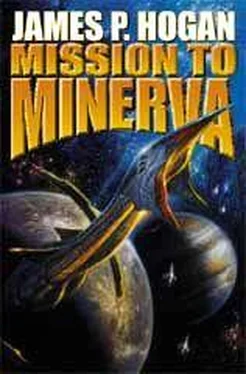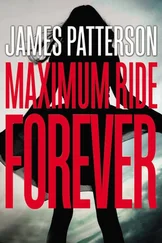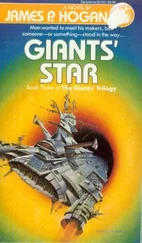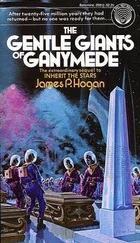Sonnebrandt seemed to get the picture. "I can't see something like that being made to work back home anytime soon," he remarked, looking at Hunt.
Hunt shook his head. "About as likely as the tribal witch doctor hanging up his mask and starting over as a bottle washer in the village clinic," he replied. "The Thuriens don't have police forces. What does that tell you about something just a little bit fundamentally different in our natures?"
"Ah, excuse me. It is Dr. Victor Hunt, the English?"
Hunt turned to find a pretty girl of about fourteen or fifteen standing by his chair, dressed in a sailor-suit school uniform. She looked Japanese and was holding a red, cloth-bound book and a pen. Hunt grinned. "None other. Who are you?"
"My name is Ko."
"Hi, Ko. What can I do for you?"
"Sorry for intrusion. But I collect many famous autographs. I would be honored if I could add also the great scientist."
"A pleasure. The honor is mine." He took the book, and while the others looked on, smiling, wrote,
To Ko, who came a long way from home. I hope you didn't follow me here just for this.
Victor Hunt Thurios, Planet Thurien In the system of the Giants' Star October, 2033
Ko looked uncertainly at Othan. "Could have Thurien, too?" she inquired a shade timidly.
VISAR came in on the circuit-it had to be involved for her to talk to the Thurien. "You can speak Japanese, Ko. I'll take care of it."
It took Ko a moment to realize what was happening. Then she handed Othan the book. "I already have Bressin Nylek's," she said as Othan penned something in heavy Thurien Gothic-like script. "He's an officer on the Ishtar. That was the ship we came here in. I have the captain's, too."
"Very enterprising," Sonnebrandt commented.
Not wanting to leave anyone out, Ko passed her book to him and Chien in an unspoken invitation when Othan had finished. "I was hoping to find Professor Danchekker," Ko said, looking around while they complied. "The scientist who went to Ganymede, too."
"He's away right now, but-" Hunt started to say, and then caught sight of Danchekker coming down the steps from the lobby area and looking around. "No, wait. You're in luck. Here he is now." Hunt caught Danchekker's attention with a wave, and Danchekker came over. "Your fame knows no bounds, Chris. This is Ko, who collects autographs. She wants your moniker."
"What?… Oh. Yes, of course… My word, you have been busy, young lady." Danchekker sustained a smile while he added his inscription. Ko trotted away happily.
"How goes life in the rest of the universe?" Hunt asked as Danchekker pulled up a chair to join them.
"Cousin Mildred has been drilling the unfortunates who work here on the art of living with her blasted cat. Luckily, they are mostly Jevlenese. Many Thuriens are uncomfortable around carnivores. For a while there was pandemonium. She thought they'd lost it."
"The missing Lynx?" Hunt threw in.
Danchekker groaned under his breath and tried to ignore it. "Everything is arranged for Quelsang tomorrow."
"Did you find out if Porthik will be here?" Hunt asked. Porthik Eesyan was the scientific adviser from Thurios that they knew from the Jevlen expedition. He had been playing a leading part in the Multiverse work.
"Yes, he will. He has some news that he wants to give you personally, Vic. The ideas you forwarded were right on. The Thuriens have been looking into them intently. It seems they were a lot closer to success than they thought. In fact, it appears that they have actually been sending things into other universes and not realizing it!"
UNSA had, of course, communicated to the Thuriens the message from Hunt's universe-traveling other self, and the Thuriens had immediately begun exploring theoretical models and preliminary experimental setups to see what could be made of a matrix propagation approach to the problem. It turned out that a reinterpretation of some of the work they had been doing ever since the Minerva event showed they had been closer to making a breakthrough than they imagined.
Their experiments before Hunt's input had led them to propose a hypothetical particle that Duncan Watt referred to whimsically in a UNSA report as a "thurion," and the name had stuck. The thurion was invoked to account for an energy deficit observed in certain quark interactions, but direct evidence of its existence had never been observed, even in situations where predictions of finding it came close to certainty. So either thurions didn't exist, in which case the theory that said they should was flawed, or something was wrong with the methods being used to look for them. But after careful reanalysis and double checking, both the theoreticians and the experimenters insisted that their side of the house was clean. Thurions had to exist; yet the facts said they didn't.
At that point VISAR pointed out that this resolved logically if "the facts" were taken as referring to this universe, while the thurions existed in a different one. In other words, the Thuriens had stumbled on what they were trying to achieve without realizing it. The reason why they hadn't realized it was that nothing indicating such a process came out of the conventional h-space physics that they had been trying to apply. But when they reran the data using an approach based on longitudinal matrix waves of the kind Hunt had proposed, the effect followed immediately. In fact, fluctuations at the quantum level would be expected to produce something like it all the time naturally-spontaneous transfers of energy across the Multiverse "grain" that would reveal themselves as sudden appearances and disappearances of virtual particles at the smallest time scales. It perhaps accounted for the quantum-level "foam" permeating the vacuum, which physicists had known about and measured for a long time, but never been able to really explain.
Hence, the arrivals from Earth found the Thuriens in a state of considerable excitement. This was not only on account of the thurion mystery being solved, but additionally because things had already progressed significantly further. The key to the whole business, it turned out, was Thurien gravitic technology. The reason why Maxwell's equations didn't yield a longitudinal wave component was that they related only to the aspect of the underlying matrix that was described electromagnetically. Charged objects in motion experienced an electrical drag that increased with velocity. This meant that the faster they moved, the more they resisted further acceleration, which was another way of saying they exhibited an increase in mass. Energy supplied in excess of what they could absorb by changing their motion was disposed of as radiation. Eventually, all of the energy being applied would be radiated, beyond which point no further acceleration was possible and the effective mass would be infinite. This, of course, described all the experimental work carried out on Earth through the previous century and interpreted in terms of relativity theory, which had pronounced the limit on velocity to be universal. But in fact it only applied to electrical phenomena-which was neither here nor there as far as Terran scientists were concerned, since they had no means of accelerating electrically neutral matter to high speeds anyway. But the Thuriens did.
Applying their gravitic methods to the matrix dynamics proposed by Hunt produced a more general form of field equations that contained a longitudinal component with solutions perpendicular to all of the four dimensions contained in the electromagnetic tensor, which could only mean trans-Multiverse propagation. Now that they were on the right track, the Thuriens at Quelsang were already transporting away to elsewhere in the Mulitiverse-the term they used was "multiporting"-electrons and protons, the building blocks of tangible matter. The next step would be to try simple molecules.
Читать дальше











